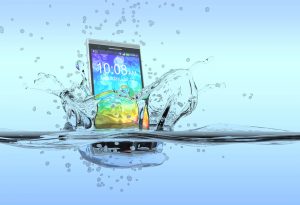10April 2024
Imagine this: you accidentally drop your beloved mobile phone into a pool of water, and panic sets in as you frantically try to salvage it. Water damage to a mobile phone can feel like a nightmare, but fear not! With the right knowledge and steps, you can restore your water damaged mobile phones to their former glory.
Assessment of Water Damage Mobile Phones
Before diving into the restoration process, it’s crucial to assess the extent of the water damage on your mobile phone. Start by inspecting the external indicators such as water ingress points, condensation under the screen, dysfunctional buttons, and malfunctioning touchscreens.
Additionally, check for any signs of corrosion, water residue, or discoloration in the charging port. Look for these signs meticulously, as they can provide valuable insight into the severity of the damage, which will help in determining the appropriate course of action.
Assessing the water damage involves a detailed examination of the phone’s components and internal circuitry. Carefully scrutinize the battery, SIM card slot, and other internal parts for any signs of water exposure.
Document any visible damage and take note of the extent to which water may have penetrated the internal components. This thorough assessment is essential in devising an effective restoration strategy and preventing further damage, as prompt action is crucial in mitigating the effects of water exposure on mobile devices.

Drying the Water Damaged Phone
Once you’ve assessed the water damage, the next crucial step is to thoroughly dry the mobile phone. Here’s a detailed process to ensure effective drying:
- Remove from Water Source: Carefully take the phone out of the water source and avoid pressing any buttons to prevent potential short circuits.
- Turn Off Immediately: Power off the phone immediately to avoid further damage and potential short circuits.
- Wipe Off Visible Water: Use a soft, lint-free cloth to gently wipe off any visible water on the exterior of the phone. Take care not to press too hard, as this could force water into the device.
- Dab Away Excess Moisture: Use a soft cloth or absorbent material to gently dab away excess moisture on the surface of the phone, including in crevices and ports.
It’s essential to avoid using heat sources such as hair dryers or microwaves, as excessive heat can further damage the internal components of the phone. Instead, opt for gentle air drying methods such as desiccants, silica gel packets, or a dedicated phone drying kit. Here are some additional tips for effective drying:
- Desiccants: Place the phone in a sealed container with desiccant packets, such as those found in medication bottles or purchased for this purpose.
- Silica Gel Packets: These are highly effective at absorbing moisture. Place the phone in a sealed container with silica gel packets to aid in drying.
- Dedicated Phone Drying Kit: Consider using a specialized phone drying kit designed to absorb residual moisture from electronic devices. Follow the instructions provided with the kit for best results.
Disassembling Water Damaged Mobile Phones
Disassembling a water-damaged mobile phone is a delicate and meticulous process that requires attention to detail and careful handling. If the phone exhibits significant water damage or remains non-functional after drying, it becomes imperative to disassemble the device for thorough inspection and cleaning.
However, it’s essential to exercise caution and precision during the disassembly to avoid causing further damage to the internal components.
- Step 1: Begin by carefully removing the back cover of the phone to gain access to the internal components. Take note of any water accumulation or moisture present in this area.
- Step 2: Once the back cover is removed, carefully detach the battery from its compartment. Check for any signs of water damage on the battery and the surrounding area.
- Step 3: Next, extract the SIM card and any other accessible components from their respective slots. Assess each component for water ingress and ensure to address any observed moisture.
- Step 4: Inspect the interior of the phone for any additional water accumulation and gently clean the internal parts using isopropyl alcohol and a soft brush. Pay careful attention to areas around the connectors and circuitry.
- Step 5: Exercise patience and allow the internal components to thoroughly dry before proceeding further. This is crucial to prevent any residual moisture causing damage during reassembly and usage.
When disassembling a mobile phone, it’s advisable to seek professional assistance if there is any uncertainty about the process or if the damage appears extensive. Attempting the disassembly without the necessary expertise may result in further harm to the device.
Cleaning the Internal Components
When it comes to cleaning the internal components of electronic devices, attention to detail is crucial. This is especially true for water-induced damage, which can wreak havoc on circuit boards and connectors if not properly addressed.
To begin the cleaning process, use a soft brush and isopropyl alcohol to meticulously remove any corrosion and residual water from the circuit boards and connectors. Pay close attention to the charging port, audio jack, and any other areas susceptible to water ingress. A magnifying glass can be helpful for inspecting intricate components.

After the initial cleaning, it’s important to conduct a thorough inspection to ensure that all visible signs of corrosion and moisture have been effectively eliminated. Any overlooked areas could lead to future malfunctions, so patience and diligence are key in this step.
Once the cleaning and inspection process is complete, allow the components to air dry completely. This critical step ensures that no moisture is trapped within the device, which could lead to future malfunctions. Air drying should be conducted in a clean, dry environment to prevent any recontamination of the components.
Replacing Damaged Parts
In cases where water damage has caused irreparable harm to specific components, replacing these parts is imperative for restoring the phone’s functionality. Common components that may require replacement include the battery, display screen, internal connectors, and logic board.
When replacing damaged parts, it’s essential to source high-quality replacement components from reputable suppliers. It’s also important to exercise caution and precision during the installation process to ensure proper functionality and avoid further damage to the device.
Components that commonly require replacement due to water damage:
- Battery
- Display screen
- Internal connectors
- Logic board
In situations where uncertainty exists about replacing damaged components, seeking professional repair services is advisable. This approach can prevent potential complications and further problems with the device.
Testing the Phone
After completing the restoration steps, it’s vital to test the phone’s functionality thoroughly before reassembling it entirely. This comprehensive testing phase will ensure that the phone is fully functional and reliable for use.
Here are the detailed steps to test the phone’s functionality:
- Component Testing: Connect the necessary components, such as the battery, display screen, and any replacement parts if applicable. Ensure that all components are securely connected and positioned correctly within the device.
- Power Up and Functional Checks: Power up the device and conduct a series of functional checks to verify its performance. These checks include:
- Verifying touchscreen responsiveness and accuracy to ensure smooth and precise interaction with the device.
- Testing call functionality, including making and receiving calls to confirm seamless communication.
- Assessing audio output quality to ensure optimal sound performance.
- Checking camera functionality, if applicable, to verify image and video capture capabilities.
- Performance and Stability Verification: Assess the phone’s overall performance and stability by testing its speed, multitasking capabilities, and response to various applications and tasks.
- Network Connectivity: Verify the phone’s network connectivity by testing Wi-Fi, cellular data, and Bluetooth functionality to ensure seamless connectivity options.
If any issues persist during the testing phase, it is crucial to revisit the restoration steps and examine the phone’s components for residual damage or irregularities. Promptly addressing any lingering issues will prevent potential long-term repercussions and ensure the phone is fully operational and reliable for the end user.
Applying a Water-Resistant Coating
To further fortify your mobile phone against potential water damage, a water-resistant coating is an effective protective measure. This coating forms a strong, impermeable barrier that repels water and moisture, safeguarding the internal components from harm.
 When selecting a water-resistant coating, consider the specific requirements of your mobile phone and look for products that offer long-lasting protection. Some coatings are designed for specific phone models, ensuring a precise fit and comprehensive coverage.
When selecting a water-resistant coating, consider the specific requirements of your mobile phone and look for products that offer long-lasting protection. Some coatings are designed for specific phone models, ensuring a precise fit and comprehensive coverage.
Application of the water-resistant coating should be carried out meticulously, following the manufacturer’s instructions to achieve thorough and uniform coverage. Additionally, periodic re-application of the coating is recommended to maintain optimal protection over time.
By incorporating a water-resistant coating, you not only provide peace of mind but also significantly reduce the risk of water damage in various environmental conditions, such as rainy weather or accidental submersion.
Educating the User
As a conscientious mobile phone user, it’s essential to be aware of practical measures to prevent and mitigate water damage. Encourage the adoption of protective accessories such as waterproof cases and pouches, especially in environments where water exposure is prevalent.
Furthermore, educate users about the appropriate actions to take in the event of water immersion, emphasizing the importance of swift response and the avoidance of makeshift drying methods. By fostering awareness, users can proactively safeguard their devices from water-related mishaps.
Conclusion
Restoring a water-damaged mobile phone demands patience, precision, and a systematic approach. By following the 7 steps outlined in this guide, you can effectively salvage your device and circumvent the perils of water damage.
Remember, swift action and thorough execution are paramount in mitigating the impact of water ingress on your mobile phone.
Now that you’re equipped with valuable insights and methods, take proactive steps to protect your device from water damage and empower yourself with the knowledge to initiate restoration when accidents occur.
Your mobile phone is an indispensable companion, and by mastering these restoration techniques, you can ensure its longevity and uninterrupted functionality.
Are you ready to take charge of safeguarding your mobile phone from water damage? Let’s embark on this journey together with confidence and resilience!
